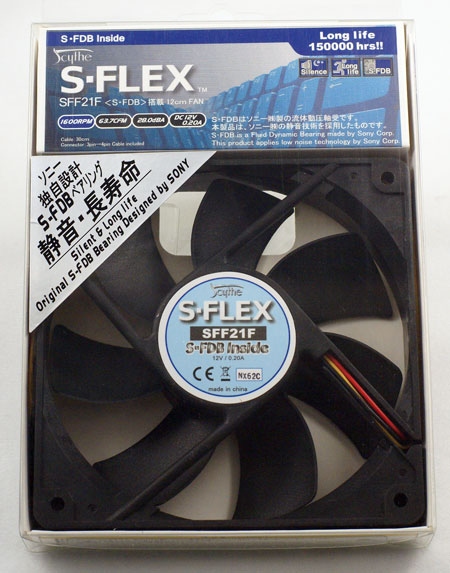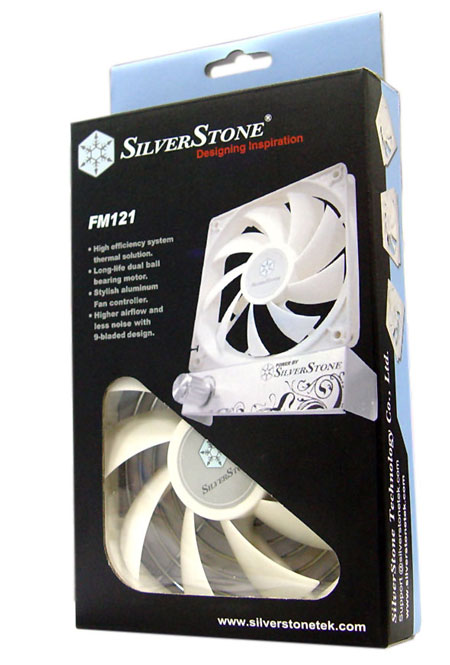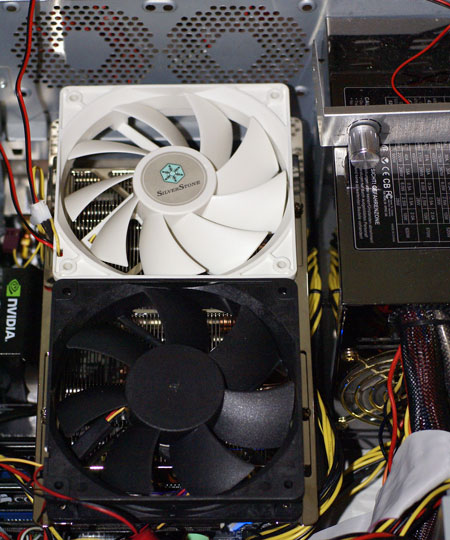Cooler Master GeminII: Performer or Poser?
by Wesley Fink on April 30, 2007 2:00 AM EST- Posted in
- Cases/Cooling/PSUs
Fan Configurations
While the Cooler Master GeminII does not ship with a cooling fan, the capability of mounting two 120mm fans on the cooler opens many possibilities. You can choose high-output fans for maximum airflow and theoretically the best performance, or you can choose two ultra-low noise fans for extremely quiet operation, or you can choose a combination of the two, such as a high output over the CPU and a silent fan over the memory area.
Since there are so many possibilities testing was performed with several configurations to assess the impact of different fan configurations on performance and noise with the Gemini II cooler.

We first tested with Scythe SFLEX SFF12F fans, which exhibit relatively low noise and high output. Two SFLEX fans were used, with each fan specified as 63.7CFM and 1600RPM at 28 dB-A.
The cooling is better than the stock Intel retail cooler and the overclocking extends a bit further at 3.83GHz compared to the 3.73GHz of the Intel retail cooler. However, these results with two fans do not really challenge any of the top coolers tested in cooling or overclocking ability.
One Scythe SFLEX was then swapped for the Silverstone FM121. This 9-bladed fan has variable output from 800RPM to 2400RPM. At 2400RPM output is an amazing 110.03CFM with noise at a less than silent 39.5 dB-A.

With the variable output you can choose silence and low output at 800RPM/17 dB-A, or you can go with noise and very high output at 2400RPM/39.5 dB-A, as well as all values in between. We tested cooling efficiency and noise with the Scythe SFLEX at full speed and the Silverstone FM121 at both 2400RPM and 800RPM.

It was amazing that the huge difference in fan output between the 800RPM and 2400RPM settings makes very little difference in overall performance of the GeminII. While temperatures were a 0C to 4C cooler with the high output fan at 2400RPM, the GeminII could still only reach a stable overclock of 3.85GHz. This compares to the better coolers with this CPU reaching 3.90GHz to 3.94GHz. Even more surprising was the fact that the low noise setting on the Silverstone FM121 combined with a quiet Scythe SFLEX still managed to reach a top overclock of 3.83GHz. This is just slightly less than the high output setting which also was exhibiting noise greater than 50 dB-A.
Finally the Cooler Master GeminII was equipped with two of the outstanding low-noise Noctua NF-S12 fans.

At standard voltage these fans are specified at 1200RPM with output at 50CFM and 17 dB-A. Lowering voltage with the U.L.N.A. reduces fan speed to 800RPM and noise to 8 dB-A. The pair of Noctua fans was run at full speeds with the pair of fans providing 100CFM of airflow on the Gemini II.
While cooling was 1C to 4C less than the super high output 110CFM fan, noise remained below the system noise floor with the pair of Noctua fans. Perhaps even more impressive was that we still managed to reach a stable 3.83GHz overclock - the same as all the other fan configurations except for the high output. The high output allowed an OC to 3.85GHz, which is just 20MHz more and hardly relevant.
It was concluded from testing four different fan configurations that the overclock limit for the Gemini II is around 3.83GHz, regardless of the fan configuration. This is certainly better than the stock Intel 3.73GHz, but it is far from the 3.9GHz to 3.94GHz we have reached in overclocks of the top coolers tested at AnandTech. The GeminII performance is below average for a top cooler and a disappointment.
If you do plan to use a GeminII in your system choose moderate output, low-noise fans for cooling. You might be tempted to use high output and super-high output fans in an effort to reach the best cooling possible, but the higher output fans make little difference on this cooler. High output fans dramatically increase noise - especially when using two with this cooler - but they do not improve performance very much.
While the Cooler Master GeminII does not ship with a cooling fan, the capability of mounting two 120mm fans on the cooler opens many possibilities. You can choose high-output fans for maximum airflow and theoretically the best performance, or you can choose two ultra-low noise fans for extremely quiet operation, or you can choose a combination of the two, such as a high output over the CPU and a silent fan over the memory area.
Since there are so many possibilities testing was performed with several configurations to assess the impact of different fan configurations on performance and noise with the Gemini II cooler.

We first tested with Scythe SFLEX SFF12F fans, which exhibit relatively low noise and high output. Two SFLEX fans were used, with each fan specified as 63.7CFM and 1600RPM at 28 dB-A.
| Dual Scythe SFLEX SFF21F | |||
| 2.93GHz | 3.73GHz | 3.83GHz | |
| Idle | 30 | 38 | 43 |
| Load | 41 | 54 | 58 |
The cooling is better than the stock Intel retail cooler and the overclocking extends a bit further at 3.83GHz compared to the 3.73GHz of the Intel retail cooler. However, these results with two fans do not really challenge any of the top coolers tested in cooling or overclocking ability.
One Scythe SFLEX was then swapped for the Silverstone FM121. This 9-bladed fan has variable output from 800RPM to 2400RPM. At 2400RPM output is an amazing 110.03CFM with noise at a less than silent 39.5 dB-A.

With the variable output you can choose silence and low output at 800RPM/17 dB-A, or you can go with noise and very high output at 2400RPM/39.5 dB-A, as well as all values in between. We tested cooling efficiency and noise with the Scythe SFLEX at full speed and the Silverstone FM121 at both 2400RPM and 800RPM.
| Silverstone FM121@2400RPM + Scythe SFLEX SFF21F | |||
| 2.93GHz | 3.73GHz | 3.85GHz | |
| Idle | 30 | 36 | 41 |
| Load | 38 | 50 | 56 |

| Silverstone FM121@800RPM + Scythe SFLEX SFF21F | |||
| 2.93GHz | 3.73GHz | 3.83GHz | |
| Idle | 33 | 38 | 41 |
| Load | 39 | 54 | 58 |
It was amazing that the huge difference in fan output between the 800RPM and 2400RPM settings makes very little difference in overall performance of the GeminII. While temperatures were a 0C to 4C cooler with the high output fan at 2400RPM, the GeminII could still only reach a stable overclock of 3.85GHz. This compares to the better coolers with this CPU reaching 3.90GHz to 3.94GHz. Even more surprising was the fact that the low noise setting on the Silverstone FM121 combined with a quiet Scythe SFLEX still managed to reach a top overclock of 3.83GHz. This is just slightly less than the high output setting which also was exhibiting noise greater than 50 dB-A.
Finally the Cooler Master GeminII was equipped with two of the outstanding low-noise Noctua NF-S12 fans.

At standard voltage these fans are specified at 1200RPM with output at 50CFM and 17 dB-A. Lowering voltage with the U.L.N.A. reduces fan speed to 800RPM and noise to 8 dB-A. The pair of Noctua fans was run at full speeds with the pair of fans providing 100CFM of airflow on the Gemini II.
| Dual Noctua NF-S12 | |||
| 2.93GHz | 3.73GHz | 3.83GHz | |
| Idle | 30 | 39 | 43 |
| Load | 39 | 54 | 58 |
While cooling was 1C to 4C less than the super high output 110CFM fan, noise remained below the system noise floor with the pair of Noctua fans. Perhaps even more impressive was that we still managed to reach a stable 3.83GHz overclock - the same as all the other fan configurations except for the high output. The high output allowed an OC to 3.85GHz, which is just 20MHz more and hardly relevant.
It was concluded from testing four different fan configurations that the overclock limit for the Gemini II is around 3.83GHz, regardless of the fan configuration. This is certainly better than the stock Intel 3.73GHz, but it is far from the 3.9GHz to 3.94GHz we have reached in overclocks of the top coolers tested at AnandTech. The GeminII performance is below average for a top cooler and a disappointment.
If you do plan to use a GeminII in your system choose moderate output, low-noise fans for cooling. You might be tempted to use high output and super-high output fans in an effort to reach the best cooling possible, but the higher output fans make little difference on this cooler. High output fans dramatically increase noise - especially when using two with this cooler - but they do not improve performance very much.










44 Comments
View All Comments
yyrkoon - Wednesday, May 2, 2007 - link
err, make that the second to the last page. Sorry.dm - Monday, April 30, 2007 - link
Nice review Wesley. I have owned this cooler and it does have its own merit. While it failed to beat the competition, what I can share is that I used this fan on an overclocked QX6700@3.2GHz at stock vCore and it performed great. If anyone would like to use it to achieve 3.8GHz+++, I suggest they get a quad core instead, say an X3210 and overclock it to 3GHz and use this cooler with a silent fan. With such cooling power, and since I have tested it personally, this cooler is great and should perform at par with competing ones.My only gripe is the price. The Ninja RevB I owned can cool the same quad core at same voltage but with much lower price tag.
joex444 - Monday, April 30, 2007 - link
This thing just got pwned. It's obviously a poser. All the extra fin space did nothing, and a 2nd fan proved to be a novelty.LaGUNaMAN - Wednesday, May 2, 2007 - link
Thanks for the review. I was waiting for this a long time. Definitely the best Gemini II review out there. (^^,)evident - Monday, April 30, 2007 - link
is it me or does thermalright xp/ultra/whatever 120 series own the competition constantly? every review i read this cooler dominates the market. I'm happy to own an xp-120 and that it's not getting topped anytime soon it seems :)stromgald - Monday, April 30, 2007 - link
Um, the XP-120 has been topped by the Ultra-120 (which is a completely different design than the XP), Scythe Ninja, and Zalman CNPS9500 to name a few. The Ninja barely edges it out, and the Ultra-120 beats the XP-120 by a good margin. The Zalman beats it in °C rise per W of processor heat, but is also noisier. Thermalright's good, but it's not like the competition is that far off at all.P.S. Thermalright doesn't have a 120 'series'. It's more like the XP series (XP-120, XP-90), SI series (SI-128, SI-97), and Ultra Series (Ultra-120, Ultra-90). The number is related to fan size, the name is the overall design/series.
Wesley Fink - Monday, April 30, 2007 - link
Thermalright has advised that the Ultra-120 eXtreme issues with the Socket 775 adapter have been resolved and the eXtrme is now in full production. For those who asked, the IFX-14 production has been delayed and Thermalright is now looking at an end of May release for the IFX-14.We will do an update on the performance of the production Ultra-120 eXtreme which is on its way to the labs.
TA152H - Monday, April 30, 2007 - link
Not to state the obvious, but shouldn't you have tested this thing with no fans? I mean, you get a heatsink with no fans at all, that says it can run with no fans, and kind of sucks when used with fans. Hmmmm, would kind of hit me like an airborne brick that I should probably test it without any fans at all, and see if it works. Cooler Master in my experience has been a pretty good company, and it makes me wonder why they made a cooler like this one that sucks so bad. Except maybe it doesn't, and for whatever peculiar reason is exceptional at running with no fans vis-a-vis other heat sinks with no fans. Of course, it could suck at that as well, but it's so obvious a question, I'm surprised no attempt was made to answer it. It could also be potentially useful. A sucky cooler like this is of little or no interest to people with fans, but if it cooled as well as a stock heat sink/fan, without the fan, that would be attractive to a much greater audience.I'm also surprised they are still making these massive beasts. With the death of the horrible P7, you'd think they would start making more reasonable sized heat sinks - unless they needed it this big to work fanless.
Wesley Fink - Monday, April 30, 2007 - link
We did try to test with no fans, but temperatures immediately ran to 70C under load at stock X6800 speeds and the system rebooted. I was not comfortable continuing a "no-fan" test under those conditions. perhaps this should have been mentioned in the review, but the results already pointed to less than stellar cooling efficiency compared to the Thermalrights, for example, which actually did fanless cooling within acceptable temperature ranges.As we have also stated several times, our current test bed is not well setup for testing fanless coolers. THe new test bed, which will be introduced with the 120mm fan roundup, is much better in that regard and will better support reliable, comparable results with fanless cooling.
TA152H - Monday, April 30, 2007 - link
OK, thanks.I think you should mention that in the article, because that was the first thing that popped into my head. "Can I use this thing fanless at stock clock speeds?"
With regards to the poor cooling, with some stuff it's bad to extrapolate data, even if it's logical. More specifically, it could be possible that one did better with fans, and another without, so I resist making assumptions on stuff like that. Put another way, if you were a designer, and I told you to make two heat sinks, one that was designed to work with a fan, and one that was designed to work without, would they end up being different? I would think so, but really I don't know enough to be sure. Consequently, I think stuff like that should be spelled out instead of assumed. In this case, it sucked at everything, but that may not always be the case.
Anyway, thanks for your response. I wouldn't want to ruin my processor either, so I can understand why you'd stop testing right away. I would have done the same.